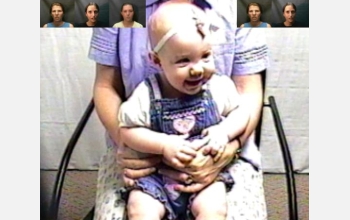News Release 06-032
And Baby Counts Three...
Infants appear to understand numbers even before they can talk

By matching voices to images, a baby shows a grasp of the abstract concept of number.
February 15, 2006
This material is available primarily for archival purposes. Telephone numbers or other contact information may be out of date; please see current contact information at media contacts.
In a study that could shed light on how infants first grasp the concept of number--as well as the evolutionary origins of that ability--researchers have found evidence that babies have an abstract numerical sense even before they learn to talk.
Duke University scientists Kerry Jordan and Elizabeth Brannon published their findings the week of Feb. 13-17, 2006, in the Proceedings of the National Academy of Sciences.
The research was sponsored by the National Institute of Mental Health, the National Science Foundation and the John Merck Fund.
Jordan and Brannon presented seven-month-old infants with the voices of two or three women saying, "Look." At the same time, they showed the babies two video images: one with two women saying the word and the other with three women doing so. The researchers found that the babies spent significantly more time looking at the video image that matched the number of women talking. From that, the researchers concluded that the infants were transferring their perception of number across two different senses, sight and sound--which suggested, in turn, that babies have a truly abstract sense of numerical concepts.
In earlier work, Jordan and Brannon performed similar tests on monkeys, which also seem to exhibit numerical perception across senses.
"As a result of our experiments, we conclude that the babies are showing an internal representation of 'two-ness' or 'three-ness' that is separate from sensory modalities and, thus, reflects an abstract internal process," said Brannon. "These results support the idea that there is a shared system between preverbal infants and nonverbal animals for representing numbers."
-NSF-
Media Contacts
M. Mitchell Waldrop, NSF, (703) 292-7752, email: mwaldrop@nsf.gov
Dennis Meredith, Duke University, 919) 681-8054, email: dennis.meredith@duke.edu
Principal Investigators
Elizabeth M. Brannon, Duke University, (919) 668-6201, email: brannon@duke.edu
Related Websites
Duke University news release: http://www.dukenews.duke.edu/2006/02/brannonjordanpnas.html
Duke University news release on number concepts in monkeys: http://www.dukenews.duke.edu/2005/06/BrannonCurrBio.html
The U.S. National Science Foundation propels the nation forward by advancing fundamental research in all fields of science and engineering. NSF supports research and people by providing facilities, instruments and funding to support their ingenuity and sustain the U.S. as a global leader in research and innovation. With a fiscal year 2023 budget of $9.5 billion, NSF funds reach all 50 states through grants to nearly 2,000 colleges, universities and institutions. Each year, NSF receives more than 40,000 competitive proposals and makes about 11,000 new awards. Those awards include support for cooperative research with industry, Arctic and Antarctic research and operations, and U.S. participation in international scientific efforts.
Connect with us online
NSF website: nsf.gov
NSF News: nsf.gov/news
For News Media: nsf.gov/news/newsroom
Statistics: nsf.gov/statistics/
Awards database: nsf.gov/awardsearch/
Follow us on social
Twitter: twitter.com/NSF
Facebook: facebook.com/US.NSF
Instagram: instagram.com/nsfgov


